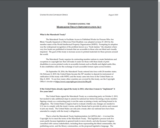
What is the Marrakesh Treaty? The Marrakesh Treaty to Facilitate Access to Published Works for Persons Who Are Blind, Visually Impaired or Otherwise Print Disabled, was adopted on June 27, 2013 by the member states of the World Intellectual Property Organization (WIPO). Prompting its adoption was the widespread recognition of the problem known as a “book famine,” the situation where very few books are published in formats that are accessible to those who are blind and visually impaired. The goal of this treaty is increase access to printed materials for these persons around the world. The Marrakesh Treaty requires its contracting member nations to create limitations and exceptions to copyright law that will make it easier for those with these kinds of print disabilities to access printed works in accessible formats such as Braille and digital audio files. It also establishes rules for the exchange of such accessible format copies across borders. On September 30, 2016, the Marrakesh Treaty entered into force with 20 member states. On February 8, 2019, the United States became the 50th member to deposit its instrument of ratification of this treaty with WIPO, and the treaty came into force in the United States on May 8, 2019. To see how many other countries are covered by this treaty, see the Copyright Office’s circular at https://www.copyright.gov/circs/circ38a.pdf.
- Subject:
- Education
- Special Education
- Material Type:
- Primary Source
- Author:
- United State Copyright Office
- Date Added:
- 08/04/2022